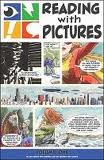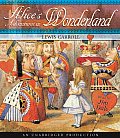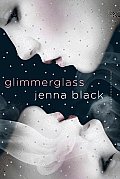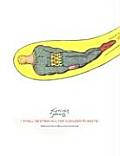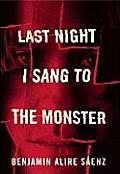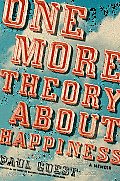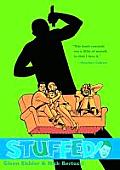Link to this review in the form of a comic strip by billba tagged comic strips • literary • anthology
Link to this review by rosie tagged literary • classic • fantasy
The story is about a girl named Alice. She falls asleep and has a really long dream. She ate different things that made her bigger and smaller so she couldn’t get into the garden and she couldn’t get out of the White Rabbit’s house. She meets a cat named the Cheshire Cat who can disappear. She meets a queen who invites her to play croquet. The queen is crazy.
Why I picked it up: I liked the girl on the front cover.
Why I finished it: I wanted to find out what happened to the girl. She was nice. And I really like the guy who told the story because he did lots of interesting voices.
I’d give it to: My friend Malia because she loves cats so she’d like the Cheshire Cat. And she’d like the queen yelling, “Off with his head!”
Link to this review by flemtastic tagged romance • fantasy • coming of age
Dana’s mother has showed up drunk at one too many school functions, so she leaves for her father’s mysterious residence in Avalon. He is a powerful politician in the unique in-between place where Faerie magic and real world machinery can coexist. Word gets out that she is coming. The powers that be fear her ability to take magic into the real world and machines into Faerie will tip the balance of power. She cannot figure out who to trust, including Ethan, the Faerie dude she falls for. Finally, Dana takes matters into her own hands.
Why I picked it up: The compelling, glossy cover with two dreamy headshots of Dana, one facing up, one down. I feel somewhat like a magpie, choosing a book for its shininess, but Faerie is big right now and I have teen girls swooning for it in my library.
Why I finished it: Dana’s abilities reminded me of Piers Anthony’s Centaur Isle where magic can exist in a certain radius around the main character in the mundane world. Dana’s rebellion against being used in others’ political games is dangerous and unlikely to succeed. I wanted to see if she could triumph.
I’d give it to: The students in the high school where I’m a librarian who liked Holly Black’s Ironside and Tithe. Jill, who complains that she’s a pawn at the fast food place where she works.
Link to this review by sarahhunt tagged superhero • history • science fiction • graphic novel
Comic books featuring space heroes and jungle heroes and heroic lumberjacks from the very brief period Hanks published, 1939-1941. Each face in his strips are grotesquely overdrawn, heavy lines emphasizing heroic faces that are oddly too delicate and too small for their bodies or villainous faces that are grotesque caricatures, like mud stuck on Neanderthal skulls. The plots are similarly oversimplified (a superhero with almost infinite power can defeat the bad guys easily) and filled with overdone action to almost a baroque scale (not only are the baddies’ plans strangely complex, but the punishments for those plans are, too). The dialogue is more outlandish than any pulp novel ever written.
Why I picked it up: I saw a frame of one comic online and it was super crazy. The art style was really compelling and the title promised stories to match.
Why I finished it: t’s like you had described superhero comics to someone who had never seen them, who then made an even more extreme version of what had been described. I recognized aspects of Hanks’ art in Ralph Bakshi and R. Crumb — he either influenced them or was well ahead of his time. His work is kind of like finding a working clock-radio in a Mayan tomb. The appeal of these comics is not simple. They are both awful and groundbreaking, and the artist was by all accounts a hideous human being. Why did Hanks draw like this? Did he miss the point of superhero comics or did he hit on some essential aspect of the art?
Hanks’ work was previously hard to find and had almost a cult following. The work that went into locating these comics for reprint clearly deserved the Eisner award. The comics essay at the end, which won a second Eisner, tells how the editor found out more about the enigmatic Hanks.
I’d give it to: Have you seen the hand-painted American movie posters in Ghana? The posters are based on the movies, but draw on African art and cultural sensibilities. If you like those posters and also wonder if a movie studio could make a film based on those posters, you would probably like this book.
Link to this review by flemtastic tagged literary • coming of age
Eighteen-year-old Zach is found on the side of the road and taken to the hospital where he is treated for alcohol poisoning. His desire is to never remember the trauma that got him there. The rest of the book is Zach’s journey through rehab and beyond, despite his negative thoughts and the “monster” that he feels lives in him. Zach’s roommate, Rafael, is a soul mate despite a thirty-year difference in age. As Zach progresses through therapy, he must deal with his demons and remember the past.
Why I picked it up: It was nominated for the ALA’s Best Fiction for Young Adults and I serve on the committee.
Why I picked it up: It was nominated for the ALA’s Best Fiction for Young Adults and I serve on the committee.
Why I finished it: It was a sad, compelling story of a damaged young man who is attempting to get his life back in therapy. Zach’s relationships with his fellow inpatients, especially Rafael and his therapist, Adam, who is refreshingly understanding and capable at the same time, really make the book. The characters in the group are endearing and raw, odd but realistic. This is an unflinching peek into the grief and pain of addiction that is dark and depressing, yet uplifting. I hope I only ever experience it on the page.
I’d give it to: Jenna who likes intense therapy books like Girl, Interrupted. JB, who I hope would recognize himself in the description of problem drinking.
Link to this review by geneambaum tagged poetry • literary • biography
Paul Guest broke his neck when he was a kid. His inability to walk and care for himself without help has affected how he lives, studies, and writes.
Why I picked it up: Books with the word “happiness” in the title give me hives, and the subtitle “a memoir” usually means I won’t pick it up. But I had the galley on my kitchen table late one night when I was talking to my friend, Dave. He went to the bathroom. I sipped my scotch. And I opened the book.
Why I finished it: After I started it, I could not put it down. It reminds me of the novels of one of my favorite writers, James Sallis, who is also a poet. Neither wastes my time with useless scenes. Both load emotion into their books without without beating me over the head with it.
I’d give it to: Anyone who read the article on Roger Ebert in Esquire about living with cancer, but who couldn’t watch the the Oprah interview with him which reduced his condition to a few most emotional, applause-worthy moments.
Link to this review by geneambaum tagged graphic novel • literary • humor
Timothy Johson works in Benefits at Health to Pay. His father dies and leaves he and his half-brother the contents of The Museum of the Rare and Curious. The tacky collection of curiosities includes the last supper made out of marshmallows, a braid made from the chin hair of a bearded lady, and the Savage, an African “statue” that’s really a stuffed human being. Tim and Dr. Bright, who works at a museum, try to identify and return the remains to Africa.
Why I picked it up: First Second’s books just feel good in your hands (I love their cover stock), but the Stephen Colbert quote on the cover helped.
Why I finished it: The saggy, hairy male breast with mole in the first panel of page 36, where an office worker is asking Tim for his opinion on whether or not he’s got cancer. Tim’s half-brother’s trepanation scar. And the humorous and real family interactions throughout the book.
I’d give it to: My friend Liz who has a heightened sense of justice and a quietly wicked sense of humor.
